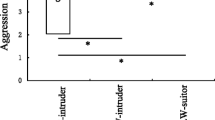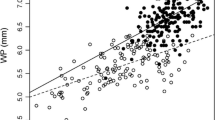Abstract
Wing pigmentation is a trait that predicts the outcome of male contests in some damselflies. Thus, it is reasonable to suppose that males would have the ability to assess wing pigmentation and adjust investment in a fight according to the costs that the rival may potentially impose. Males of the damselfly Mnesarete pudica exhibit red-coloured wings and complex courtship behaviour and engage in striking male–male fights. In this study, we investigated male assessment behaviour during aerial contests. Theory suggests that the relationship between male resource-holding potential (RHP) and contest duration describes the kind of assessment adopted by males: self-assessment, opponent-only assessment or mutual assessment. A recent theory also suggests that weak and strong males exhibit variations in the assessment strategies adopted. We estimated male RHP through male body size and wing colouration (i.e. pigmentation, wing reflectance spectra and transmission spectra) and studied the relationship between male RHP and contest duration from video-documented behavioural observations of naturally occurring individual contests in the field. The results showed that males with more opaque wings and larger red spots were more likely to win contests. The relationships between RHP and contest durations partly supported the self-assessment and the mutual assessment models. We then experimentally augmented the pigmented area of the wings, in order to evaluate whether strong and weak males assess rivals’ RHP through wing pigmentation. Our experimental manipulation, however, clearly demonstrated that strong males assess rivals’ wing pigmentation. We finally suggest that there is a variation in the assessment strategy adopted by males.



Similar content being viewed by others
References
Anderson CN, Cordoba-Aguilar A, Drury JP, Grether GF (2011) An assessment of marking techniques for odonates in the family Calopterygidae. Entomol Exp Appl 141(3):258–261
Arnott G, Elwood RW (2009) Assessment of fighting ability in animal contests. Anim Behav 77:991–1004
Bradbury JW, Vehrencamp SL (2011) Principles of animal communication. Sinauer Associates, Sunderland
Bybee SM, Johnson KK, Gering EJ, Whiting MF, Crandall KA (2012) All the better to see you with: a review of odonate color vision with transcriptomic insight into the odonate eye. Org Divers Evol 12(3):241–250
Constant N, Valbuena D, Rittschof CC (2011) Male contest investment changes with male body size but not female quality in the spider Nephila clavipes. Behav Process 87(2):218–223
Contreras-Garduño J, Canales-Lazcano J, Córdoba-Aguilar A (2006) Wing pigmentation, immune ability, fat reserves and territorial status in males of the rubyspot damselfly, Hetaerina americana. J Ethol 24(2):165–173
Contreras-Garduño J, Lanz-Mendoza H, Córdoba-Aguilar A (2007a) The expression of a sexually selected trait correlates with different immune defense components and survival in males of the American rubyspot. J Insect Physiol 53(6):612–621
Contreras-Garduño J, Buzatto BA, Abundis L, Nájera-Cordero K, Córdoba-Aguilar A (2007b) Wing colour properties do not reflect male condition in the American rubyspot (Hetaerina americana). Ethology 113(10):944–952
Contreras-Garduño J, Buzatto BA, Serrano-Meneses MA, Najero-Cordero K, Córdoba-Aguilar A (2008) The size of the red wing spot of the American rubyspot as a heightened condition-dependent ornament. Behav Ecol 19:724–732
Contreras-Garduño J, Córdoba-Aguilar A, Lanz-Mendoza H, Cordero Rivera A (2009) Territorial behaviour and immunity are mediated by juvenile hormone: the physiological basis of honest signalling? Func Ecol 23:157–163
Córdoba-Aguilar A (2002) Wing pigmentation in territorial male damselflies Calopteryx haemorrhoidalis: a possible relationship to sexual selection. Anim Behav 63(4):759–766
Córdoba-Aguilar A, Cordero-Rivera A (2005) Evolution and ecology of Calopterygidae (Zygoptera: Odonata): status of knowledge and research perspectives. Neotrop Entomol 34:861–879
Elwood RW, Arnott G (2012) Understanding how animals fight with Lloyd Morgan’s canon. Anim Behav 84(5):1095–1102
Elwood RW, Arnott G (2013) Assessments in contests are frequently assumed to be complex when simple explanations will suffice. Anim Behav 86(5):e8–e12
Endler JA (1990) On the measurement and classification of color in studies of animal color patterns. Biol J Linn Soc 41:315–352
Enquist M, Leimar O (1983) Evolution of fighting behaviour: decision rules and assessment of relative strength. J Theor Biol 102:387–410
Fawcett TW, Mowles SL (2013) Assessments of fighting ability need not be cognitively complex. Anim Behav 86(5):e1–e7
Fitzstephens DM, Getty T (2000) Colour, fat and social status in male damselflies, Calopteryx maculata. Anim Behav 60(6):851–855
Gammell MP, Hardy ICW (2003) Contest duration: sizing up the opposition? Trends Ecol Evol 18:491–493
Gołąb MJ, Śniegula S, Drobniak SM, Zając T, Serrano-Meneses MA (2013) Where do floaters settle? An experimental approach in odonates. Anim Behav 86(5):1069–1075
Grether GF (1996) Intrasexual competition alone favors a sexually dimorphic ornament in the rubyspot damselfly Hetaerina americana. Evolution 50(5):1949–1957
Guillermo-Ferreira R, Bispo PC (2012) Male and female interactions during courtship of the Neotropical damselfly Mnesarete pudica (Odonata: Calopterygidae). Acta Ethol 15:173–178
Guillermo-Ferreira R, Del-Claro K (2011) Resource defense polygyny by Hetaerina rosea Selys (Odonata: Calopterygidae): influence of age and wing pigmentation. Neotrop Entomol 40:78–84
Guillermo-Ferreira R, Del-Claro K (2012) Territoriality and male-biased sexual size dimorphism in Argia reclusa (Odonata: Zygoptera). Acta Ethol 15(1):101–105
Guillermo-Ferreira R, Therézio EM, Gehlen MH, Bispo PC, Marletta A (2014) The role of wing pigmentation, UV and fluorescence as signals in a Neotropical damselfly. J Insect Behav 27(1):67–80
Hardy IC, Briffa M (Eds.) (2013) Animal contests. Cambridge University Press
Hooper RE, Tsubaki Y, Siva-Jothy MT (1999) Expression of a costly, plastic secondary sexual trait is related with age and condition in a damselfly with two male morphs. Physiol Entomol 24(4):364–369
Hsu Y, Lee SP, Chen MH, Yang SY, Cheng KC (2008) Switching assessment strategy during a contest: fighting in killifish Kryptolebias marmoratus. Anim Behav 75:1641–1649
Jennings DJ, Gammell MP, Payne RJ, Hayden TJ (2005) An investigation of assessment games during fallow deer fights. Ethology 111:511–525
Junior RSL, Peixoto PEC (2013) Males of the dragonfly Diastatops obscura fight according to predictions from game theory models. Anim Behav 85(3):663–669
Kasumovic MM, Mason AC, Andrade MC, Elias DO (2011) The relative importance of RHP and resource quality in contests with ownership asymmetries. Behav Ecol 22:39–45
Keil PL, Watson PJ (2010) Assessment of self, opponent and resource during male–male contests in the sierra dome spider, Neriene litigiosa: Linyphiidae. Anim Behav 80(5):809–820
Kemp DJ, Alcock J (2003) Lifetime resource utilization, flight physiology, and the evolution of contest competition in territorial insects. Am Nat 162(3):290–301
Kemp DJ, Alcock J, Allen GR (2006a) Sequential size assessment and multicomponent decision rules mediate aerial wasp contests. Anim Behav 71:279–287
Kemp DJ, Wiklund C, Van Dyck H (2006b) Contest behaviour in the speckled wood butterfly (Pararge aegeria): seasonal phenotypic plasticity and the functional significance of flight performance. Behav Ecol Sociobiol 59(3):403–411
Kuitunen K, Gorb SN (2011) Effects of cuticle structure and crystalline wax coverage on the coloration in young and old males of Calopteryx splendens and Calopteryx virgo. Zoology 114(3):129–139
Marden JH, Rollins RA (1994) Assessment of energy reserves by damselflies engaged in aerial contests for mating territories. Anim Behav 48(5):1023–1030
Marden JH, Waage JK (1990) Escalated damselfly territorial contests are energetic wars of attrition. Anim Behav 39:954–959
Maynard Smith J, Price GR (1973) Logic of animal conflict. Nature 246:15
Mesterton-Gibbons M, Heap SM (2014) Variation between self-and mutual assessment in animal contests. Am Nat 183:199–213
Mesterton-Gibbons M, Marden JH, Dugatkin LA (1996) On wars of attrition without assessment. J Theor Biol 181(1):65–83
Montgomerie R (2008) CLR, version 1.05. Queen’s University, Kingston, Canada. (http://post.queensu.ca/~mont/color/analyze.html)
Pajunen V (1966) Aggressive behavior and territoriality in a population of Calopteryx virgo L. (Odonata: Calopterygidae). Ann Zool Fenn 3:201–214
Palaoro AV, Dalosto MM, Costa JR, Santos S (2014) Freshwater decapod Aegla longirostri uses a mixed assessment strategy to resolve contests. Anim Behav 95:71–79
Parker GA (1974) Assessment strategy and evolution of fighting behavior. J Theor Biol 47:223–243
Payne RJH (1998) Gradually escalating fights and displays: the cumulative assessment model. Anim Behav 56:651–662
Payne RJH, Pagel M (1996) Escalation and time costs in displays of endurance. J Theor Biol 183:185–193
Payne RJH, Pagel M (1997) Why do animals repeat displays? Anim Behav 54:109–119
Peixoto PEC, Benson WW (2011) Fat and body mass predict residency status in two tropical satyrine butterflies. Ethology 117(8):722–730
Plaistow SJ, Siva-Jothy MT (1996) Energetic constraints and male mate-securing tactics in the damselfly Calopteryx splendens xanthostoma (Charpentier). Proc R Soc B 263:1233–1239
Raihani G, Serrano-Meneses MA, Córdoba-Aguilar A (2008) Male mating tactics in the American rubyspot damselfly: territoriality, nonterritoriality and switching behaviour. Anim Behav 75(6):1851–1860
Rüppell G, Hilfert-Rüppell D (2013) Biting in dragonfly fights. Int J Odonatol 16(3):219–229
Schultz TD, Fincke OM (2009) Structural colours create a flashing cue for sexual recognition and male quality in a Neotropical giant damselfly.Funct Ecol 23: 724–732.
Serrano-Meneses MA, Córdoba-Aguilar A, Méndez V, Layen SJ, Székely T (2007) Sexual size dimorphism in the American rubyspot: male body size predicts male competition and mating success. Anim Behav 73(6):987–997
Small J, Cotton S, Fowler K, Pomiankowski A (2009) Male eyespan and resource ownership affect contest outcome in the stalk-eyed fly, Teleopsis dalmanni. Anim Behav 78(5):1213–1220
Stavenga DG, Leertouwer HL, Hariyama T, De Raedt HA, Wilts BD (2012) Sexual dichromatism of the damselfly Calopteryx japonica caused by a melanin-chitin multilayer in the male wing veins. PLoS One 7:e49743
Stuart-Fox D (2006) Testing game theory models: fighting ability and decision rules in chameleon contests. Proc R Soc B 273:1555–1561
Suhonen J, Rantala MJ, Honkavaara J (2008) Territoriality in odonates. In: Córdoba-Aguilar A (ed) Dragonflies and damselflies: model organisms for ecological and evolutionary research. Oxford University Press, Oxford, pp 203–218
Taylor PW, Elwood RW (2003) The mismeasure of animal contests. Anim Behav 65(6):1195–1202
Waage JK (1988) Confusion over residency and the escalation of damselfly territorial disputes. Anim Behav 36(2):586–595
Acknowledgments
RGF and PCB thank CAPES, CNPq (Proc. numbers. 307577/2011-2, 237120/2012-7) and FAPESP (Proc. numbers 12/21196-8, 13/00406-7) for financial support. We thank O.M. Fincke (University of Oklahoma) and two anonymous referees for valuable comments.
Author information
Authors and Affiliations
Corresponding author
Additional information
Communicated by: Sven Thatje
Electronic supplementary material
Below is the link to the electronic supplementary material.
(WMV 6070 kb)
Rights and permissions
About this article
Cite this article
Guillermo-Ferreira, R., Gorb, S.N., Appel, E. et al. Variable assessment of wing colouration in aerial contests of the red-winged damselfly Mnesarete pudica (Zygoptera, Calopterygidae). Sci Nat 102, 13 (2015). https://doi.org/10.1007/s00114-015-1261-z
Received:
Revised:
Accepted:
Published:
DOI: https://doi.org/10.1007/s00114-015-1261-z




